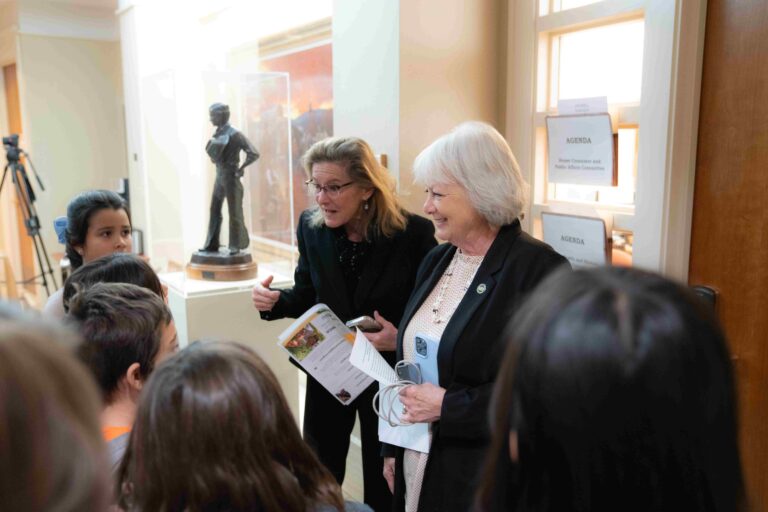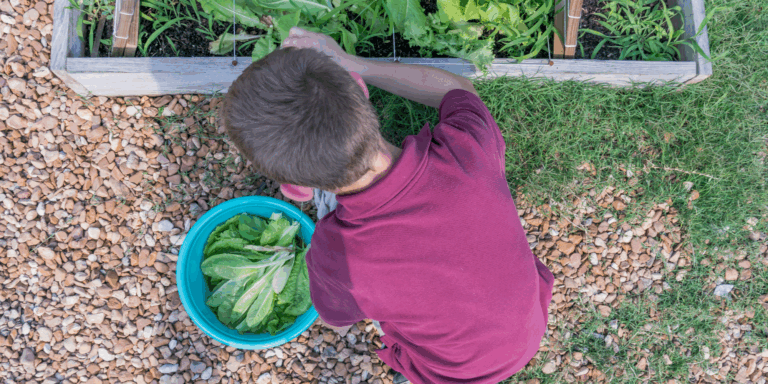What’s Next? School Nutrition Teams Keep on Keeping On
FoodCorps checked in with several school nutrition directors about how the pandemic is leading them to think differently about how to serve students.
Help nourish students’ minds, bodies, and hearts this holiday season!
FoodCorps checked in with several school nutrition directors about how the pandemic is leading them to think differently about how to serve students.

Despite months of school closures due to COVID-19 and emergency meal service that decimated the budgets of many school districts’ meal programs, numerous districts are transitioning to providing summer meals, often for the first time. And while awaiting decisions about whether or how in-school learning will resume, school nutrition teams are planning for multiple modes of meal service. Two things are certain: The months ahead won’t be business as usual, and school nutrition professionals will meet the challenges ahead with resilience and spirit.
FoodCorps checked in with several school nutrition directors about how these trying times are also prime opportunities to reset and think differently about how to serve students.
Jeanne Reilly, Director of School Nutrition for RSU #14 in Windham, Maine, spent the spring coordinating the distribution of meals and meal kits through a district- and donation-funded backpack program, a modified food pantry that provided lots of produce, dairy and shelf-stable items.
Reilly’s colleague, Chef Ryan Roderick, regularly filmed and posted videos that offered ideas for preparing recipes from the meal kits, such as hummus from garbanzo beans. “Cooking has really become a part of the instructional process and education day,” says Reilly. Families posted photos of their culinary creations on the RSU #14 School Nutrition social media channels. It’s community connections like these that Reilly and Roderick hope will continue when school reopens. “Parents realize that it’s hard work being in schools,” Reilly says. “They email us every day and tell us how tired they are of planning lunch—or class time—every day, so they are grateful for what we do. I’m looking forward to where we might take that conversation now.”
As she and Roderick discuss various scenarios, she worries about funding, about getting timely information for action, about coping with product shortages, and about parents accepting school meals with more individually-wrapped, packaged items. But the worry isn’t too overwhelming; it’s simply about preparing for what might be next. Last spring, “We all changed our operational model overnight. Whatever you shifted to, you just did it,” says Reilly. “We’re going to have to do that in the fall. The new normal may be continually adapting our model as things change.”
Looking further along the next school year’s timeline, Reilly hopes that the crisis of today leads to other “amplified” conversations tomorrow, especially when it comes to the topic of universal school meals. Mere days before the shutdowns, Reilly was in Washington, D.C., at the annual Legislative Action Conference of the School Nutrition Association. “I was meeting with Senator Susan Collins and I told her that, although universal school meals would probably not be realistic for five or ten years, it’s a conversation we needed to start having now,” says Reilly. Neither could have predicted that within three to four weeks, school nutrition operations throughout Maine and all across the country would be offering meals to all kids in their communities for free.
“It’s fascinating that something that seemed so ‘pie in the sky’ is now something we’re actually doing. I think the pandemic has allowed us to amplify this conversation going forward,” says Reilly.
Sarah Doherty, a former FoodCorps service member who “fell in love with school foodservice,” has been director of child nutrition at California’s North Monterey County Unified School District for the last four years. Serving an agriculture community, the district operates the Community Eligibility Provision, which allows them to serve free breakfast, lunch, snack, and supper to all students. In the wake of school closures, Doherty’s operation transitioned to providing seven days’ of breakfasts, lunches and, eventually, suppers to families. Summer feeding is on tap. “We do it every year, but this year it takes on a whole new meaning and importance,” says Doherty.
Already contending with shortages for items like cereal and various packaged entrees, Doherty is worried about the reliability of the supply chain come fall. Her team has shifted to relying less on individually packaged entrees in favor of using bulk ingredients to make their own menu items, such as tamales and pupusas.
In the meantime, she pledges to continue to showcase how school meals are integral to the education day. “Yes, these meals are crucial for families that don’t have food, but our meals are some of the healthiest ones they’re going to get all day, regardless of their family’s budget,” Doherty says. “Healthy food is important for all students—and should be free for all students.”
When he looks at the months ahead, Chef Kevin Frank, assistant director of catering and hospitality for Detroit Public Schools, toggles between optimism and concern. During school closures, he and his team distributed seven days’ worth of meals—traditional school meals that were frozen and sent along with heating instructions—at 35 sites throughout the city. At the time of this interview, the beginning of summer, Frank shared his colleagues’ frustration and uncertainty. “I just want information—that’s my biggest ask. I want to know what we’re doing and where we’re going.”
Frank’s desire for more answers informs one of his top wish list items for the future of school foodservice. “I want to see more integration of school foodservice into the decision-making process. Not just at our individual district, but around the country. As operators, we need to be at the table when decisions are being made,” says Frank, noting that presence is only part of the equation. “We’re often heard, but what we have to say isn’t always weighed equally.”
But his first priority will be to focus on what he calls “damage mitigation.” It’s going to be a challenge to potentially serve meals in the classroom, which will necessitate a pared-down menu, says Frank. “How can I make these changes and still give them the quality of food they’ve become used to?” he says. “I’m going to do all I can so that we don’t take steps backward in terms of quality and variety.”
Chef Frank is buoyed by a renewed spirit of cooperation among the education community. “Throughout this crisis, we’ve been reaching out for help in serving meals, and we’ve had teachers, custodians and para-educators all step up. I think we’re going to keep getting more respect from these groups, because they are seeing firsthand how hard our staff works every day.”
At the end of a whirlwind spring, Bertrand Weber, Director of Culinary and Wellness Services for Minneapolis Public Schools, gathered his top team members to begin the process of looking ahead to the new school year. “We discussed how we need to accept that, for the next year, we may not be able to deliver on all our basic core values for our programs,” says Weber. “We still have those values, but we may have to modify how we meet them until we can get back to some kind of normal.”
Weber is disappointed to postpone plans for introducing plant-based menu stations, expanding share tables, and other initiatives, and he acknowledges that expected requirements to serve meals in the classroom will present menu challenges. Still, he remains confident that quality and creativity will still be at the heart of their school meals operation. These twin elements in his half of Minnesota’s Twin Cities have served kids very well.
Working with an initial mandate to provide emergency meals within one mile of every household in the district, the school nutrition team kept tweaking and adapting their distribution model to an impressive extent; eventually, they were serving seven-day meal boxes from 10 different sites rotating through locations across five days—or successful meal service at 50 different locations. Weber is also grateful to be able to buy from local farmers and producers—including area providers of a turkey burger and a grass-fed beef hotdog—and he is pleased to be able to continue to support these home state businesses.
A top priority is not to go backward when it comes to the quality of meals served in the district. It’s taken them 10 years to transition away from highly processed, prepackaged items, but today, health experts are strongly recommending a reliance on individually packaged menu items for school meals. Weber is looking to the manufacturers and processors that supply the K-12 foodservice segment to be active partners in developing creative menu products that can meet these goals. He cites the loss of salad bars as an example. “How do we convert our produce to individually wrapped, but still make it appealing for students to try items and make choices? We need to ask manufacturers to be innovative—but also to minimize packaging,” says Weber.
This will be a key aspect of ensuring that school meals are not viewed merely as a hunger safety net, but as a source of nutritious, innovative nourishment for the whole community. “Yes, we’re rallying around how much we can provide to our communities in this time of need,” says Weber, “but we’re also seeing ways that school nutrition programs can bring us all together.”
“This pandemic has exposed many ways that our food systems—and the people who are working in them—are vulnerable,” says Elizabeth Marchetta, Executive Director of Food and Nutrition Services for Baltimore City Public Schools. Drawing parallels between the conditions in meat and poultry processing plants, which saw highly publicized outbreaks that numbered in the thousands in the spring, and small, crowded school kitchens, Marchetta is worried about the potential for infection spread among her team if schools reopen.
“We need time to figure out our safety procedures, because we’re either preventing infection spread or we’re actively spreading it; there’s no in-between,” says Marchetta. “It’s been a struggle to get our staff to understand that the greatest threat is not the parent who is walking up to the meal site, but the person who works next to them.”
Baltimore’s reopening plans remain uncertain, and district leaders may well opt for fully virtual learning until winter. If that’s the case, Marchetta, her team and numerous community partners can build upon a truly impressive foodservice model that they mastered in the spring. To meet the nutrition needs of children and adults at the height of the spring closures, Marchetta’s staff was managing 18 daily sites serving reimbursable, fully compliant school meals; coordinating, in partnership with World Central Kitchen, a dozen “sidewalk sites” providing a week’s worth of frozen meals; assisting with food pantries at more than 100 school sites; offering the Fresh Fruit and Vegetable Program at nearly 90 sites; and exploring the early stages of participation with USDA’s Farmers to Families Food Box. Most of these activities were expected to extend into summer.
When FoodCorps spoke with Marchetta in late May, she was also keeping tabs on how the new Pandemic EBT program would be administered. Not only would it provide valuable food assistance to all children in the district, but she expected it to prove especially helpful “to meet the needs of thousands of kids with different food allergies,” Marchetta says, explaining that making such menu accommodations with curbside meals is difficult.
What’s especially encouraging in the face of more virtual learning is hearing how Marchetta and her team continued to put the department’s urban farm to great use—in food distribution efforts and in educational activities. Pre-pandemic, a second-grade science curriculum featured several activities on plants, agriculture, insects, and pollination, and it included class trips to the farm. “But even with COVID-19, the teachers picked up classroom growing kits and were incorporating these into remote lessons,” Marchetta reports. “We also have YouTube videos featuring our full-time farmer, and classes can schedule FaceTime video conversations between the kids and the farmer.”
Marchetta would love to focus most of her attention on delivering food and education to students and families. But she can’t ignore a troubling financial forecast shared by school nutrition operations all across the country. “We’re all struggling,” says Marchetta. “We served 10,000 meals in the same period when we would normally serve 90,000. We’re not going to have the same revenue, and that will mean jobs. We’re going to need more refrigeration and equipment upgrades. We will need to change supplies. We had just switched to a new compostable tray and utensils, but we can’t use those for sending meals home. And those clamshells add up. There’s no doubt that our per-meal cost is going up.”
As a district that fully participates in the Community Eligibility Provision (CEP), Baltimore City Public Schools is already getting the highest available reimbursement by serving all meals at the free rate. But “I want to see an adequate reimbursement for school meals,” says Marchetta. “It’s time to fund school meals at the value they deserve—which is $4 to $5 per meal.”
That value is so much more than full stomachs. The pandemic, she notes, has put the spotlight on how schools can address a whole host of children’s needs—and school nutrition programs need to be an ongoing part of this effort. “I’ve always said that when it comes to shaping kids’ health behaviors, cafeteria managers are more powerful than pediatricians. School meals should be recognized as an incentive for coming to school, and what coming to school means for building community and education.”

Our 2025 Child Nutrition Policy Year in Review

Winterizing Your School Garden

5 Awesome Small Businesses by FoodCorps Alums